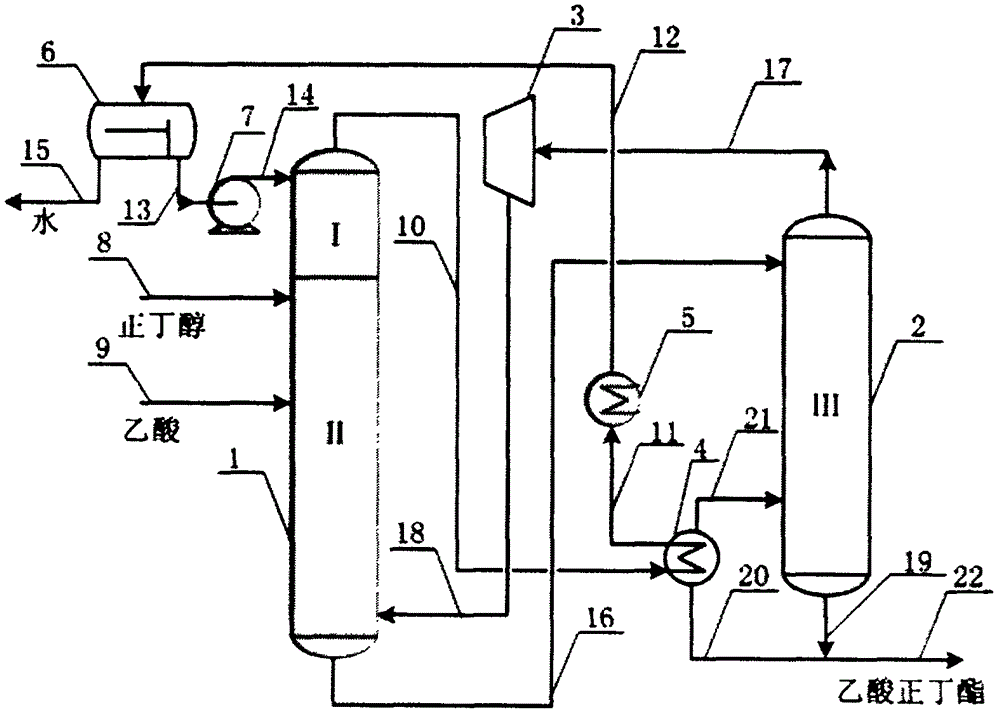A kind of synthetic process of n-butyl acetate
A technology for the synthesis of n-butyl acetate, which is applied to the preparation of carboxylic acid esters, chemical instruments and methods, and the preparation of organic compounds to achieve the effect of reducing energy consumption
- Summary
- Abstract
- Description
- Claims
- Application Information
AI Technical Summary
Problems solved by technology
Method used
Image
Examples
Embodiment 1
[0015] Example 1: Such as figure 1 As shown, the differential pressure thermal coupling reaction distillation atmospheric column (1) rectification zone (|) theoretical plate number is 5, reaction zone (II) theoretical plate number is 20, and vacuum column (2) theoretical plate number is 10 , The feed n-butanol is fed from the 6th theoretical plate (counted from top to bottom) in the atmospheric column (1), and the acetic acid is fed from the 10th theoretical plate with a molar ratio of 1:1. The flow rate and mass fraction of each incoming and outgoing stream are shown in Table 1. The temperature at the top of the atmospheric tower is 90.6℃, the temperature in the reaction zone is 91.6-116.6℃, the temperature of the phase separator is 50℃, and the temperature at the bottom of the vacuum tower is 78.0℃ , The operating pressure of the vacuum tower is 0.02MPa. The conversion rate of acetic acid is 98.39%. For the calculation of energy consumption, the same acetic acid conversion r...
Embodiment 2
[0018] Example 2: Such as figure 1 As shown, the feed composition, the molar ratio of feed n-butanol to acetic acid, the feed position and the number of theoretical plates in each zone are the same as in Example 1, and the operating pressure of the vacuum tower is 0.01 MPa. The flow rate and mass fraction of each incoming and outgoing stream are shown in Table 2. The top temperature of the atmospheric tower is 91.1℃, the temperature of the reaction zone is 91.8~118.3℃, the temperature of the phase separator is 50℃, and the temperature of the bottom of the vacuum tower is 61.6℃ . The conversion rate of acetic acid is 97.93%. For the calculation of energy consumption, the same conversion rate of acetic acid and product separation requirements are met. The heat load of the reboiler in the conventional reactive distillation process is 1925.663 kW. The top steam of the pressure column provides the heat source, so the energy consumption of only the compressor is 888.418kW, which can...
Embodiment 3
[0022] Example 3: Such as figure 1 As shown, the feed composition, the molar ratio of feed n-butanol to acetic acid, and the number of theoretical plates in each zone are the same as in Example 1. The feed n-butanol and acetic acid enter the atmospheric column from the sixth theoretical plate at the same time, and the vacuum column is operated The pressure is 0.03MPa. The flow rate and mass fraction of each incoming and outgoing stream are shown in Table 3. The top temperature of the atmospheric tower is 90.5℃, the temperature of the reaction zone is 92.5-116.1℃, the temperature of the phase separator is 50℃, and the bottom temperature of the vacuum tower is 83.2℃ . The conversion rate of acetic acid is 97.50%. For the calculation of energy consumption, the same acetic acid conversion rate and product separation requirements are met. The heat load of the reboiler in the conventional reactive distillation process is 1907.444kW. The top steam of the compression tower provides t...
PUM
 Login to View More
Login to View More Abstract
Description
Claims
Application Information
 Login to View More
Login to View More - R&D
- Intellectual Property
- Life Sciences
- Materials
- Tech Scout
- Unparalleled Data Quality
- Higher Quality Content
- 60% Fewer Hallucinations
Browse by: Latest US Patents, China's latest patents, Technical Efficacy Thesaurus, Application Domain, Technology Topic, Popular Technical Reports.
© 2025 PatSnap. All rights reserved.Legal|Privacy policy|Modern Slavery Act Transparency Statement|Sitemap|About US| Contact US: help@patsnap.com



